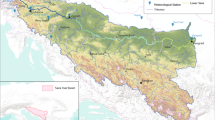Abstract
Recently much concern has been expressed regarding the impact of an increased atmospheric CO2 concentration on climate. Unfortunately, present understanding and models of the climate system are not good enough for reliable prediction of such impacts. This paper presents an analysis of recent climate data in order to illustrate the nature of regional temperature and rainfall changes in different seasons and to provide some guidance with regard to points which might be borne in mind when scenarios of future climate (especially those taking into account human impacts) are being formulated.
Since it is believed that an increased atmospheric CO2 concentration will cause a warming and models and data suggest that the Arctic is more sensitive to climatic change than other latitudes, anomalies associated with warm Arctic seasons have been studied.
The regional temperature, precipitation and pressure anomalies in the northern hemisphere for the 10 warmest Arctic winters and 10 warmest Arctic summers during the last 70 years have been investigated. Even when the Arctic area is warm, there are circulation changes such that large coherent anomalies occur elsewhere, with some regions warming and some cooling. The 10 warmest Arctic winters were characterised by larger amplitude anomalies, in the Arctic and elsewhere, than the 10 warmest summers, illustrating the difference in response between seasons. The precipitation differences for the 10 warmest Arctic winters and summers show for North America large coherent areas of increase or decrease, which again differ according to season. However, in winter the differences are not statistically significant, while the differences in two areas are significant in summer.
Similar content being viewed by others
References
Flohn, H.: 1978, ‘Estimates of a combined greenhouse effect as background for a climate scenario during global warming’. In J. Williams (Ed.), Carbon Dioxide, Climate and Society, Pergamon Press.
Flohn, H.: 1979, ‘A scenario of possible future climates - natural and man-made’, Paper prepared for World Climate Conference, Geneva.
Jenne, R. L.: 1975, ‘Data sets for meteorological research’, NCAR Tech. Note NCAR-TN/1A-111, 194 pp.
Kellogg, W. W.: 1977, ‘Effects of human activities on global climate’, WMO-No. 486. Tech. Note 156, WMO, Geneva.
Kellogg, W. W.: 1978, ‘Global influences of mankind on the climate’. In J. Gribbin (Ed.), Climatic Change, Cambridge University Press.
Manabe, S., and Wetherald, R. T.: 1975, ‘The effects of doubling the CO2 concentration on the climate of a general circulation model’, J. Atmos. Sci. 32, 3–15.
NAS: 1977, Energy and climate, National Academy of Sciences, Washington, D.C.
Schneider, S. H.: 1975, ‘On the carbon dioxide - climate confusion’, J. Atmos. Sci. 32, 2060–2066.
Smagorinsky, J.: 1977, ‘Modeling and predictability’, In Energy and Climate, National Academy of Sciences. Washington, D.C.
SMIC: 1971, Inadvertent Climate Modification, MIT Press.
van Loon, H., and Williams, J.: 1976a, ‘The connection between trends of mean temperature and circulation at the surface. Part I: Winter’, Mon. Wea. Rev. 104, 365–380.
van Loon, H., and Williams, J.: 1976b, ‘The connection between trends of mean temperature and circulation at the surface. Part II: Summer’, Mon. Wea. Rev. 104, 1003–1011.
van Loon, H., and Williams J.: 1977, ‘The connection between trends of mean temperature and circulation at the surface. Part IV: Comparison of the surface changes in the Northern Hemisphere with the upper air and with the Antarctic in winter’, Mon. Wea. Rev. 105, 636–647.
Williams, J., (Ed.): 1978, Carbon Dioxide, Climate and Society, Pergamon Press.
Williams, J., and van Loon H.: 1976a, ‘The connection between trends of mean temperature and circulation at the surface. Part III: Spring and Autumn’, Mon. Wea. Rev. 104, 1591–1596.
Williams, J., and van Loon, H.: 1976b, ‘An examination of the Northern Hemisphere sea-level pressure data set’, Mon. Wea. Rev. 104, 1354–1361.
Author information
Authors and Affiliations
Rights and permissions
About this article
Cite this article
Williams, J. Anomalies in temperature and rainfall during warm Arctic seasons as a guide to the formulation of climate scenarios. Climatic Change 2, 249–266 (1980). https://doi.org/10.1007/BF00137989
Received:
Revised:
Issue Date:
DOI: https://doi.org/10.1007/BF00137989




